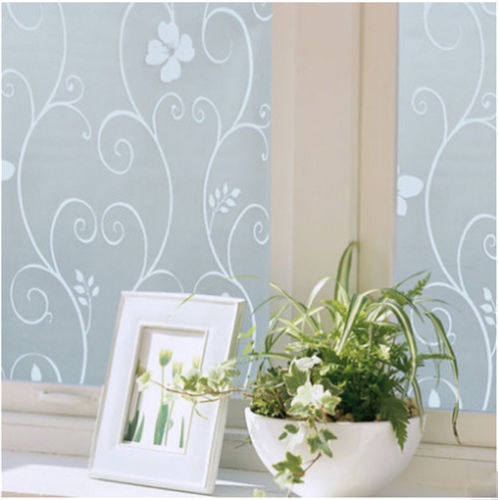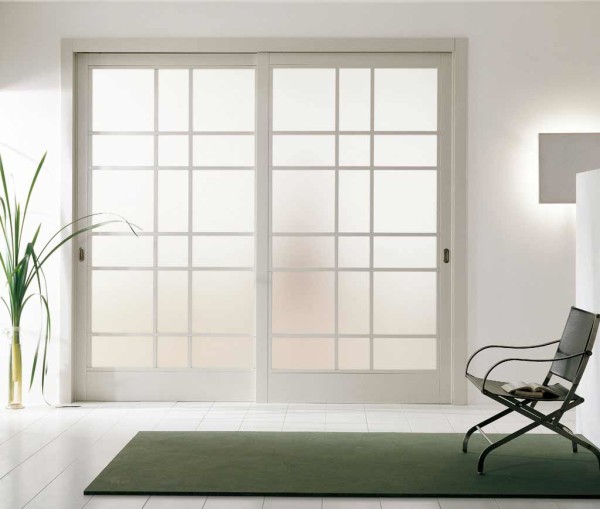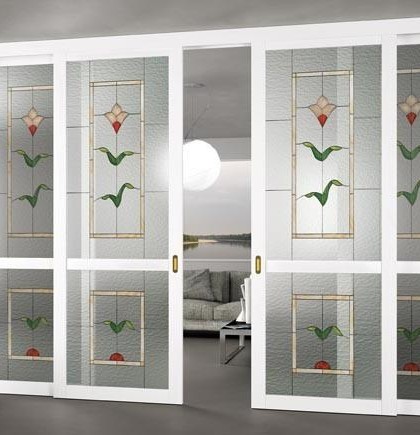Interior door glass decoration
Glass processing has become so popular and diverse that it itself has become a fashionable element, a full-fledged independent interior decoration. Consumer indicators of glass are also actively changing, giving rise to the need to improve processing. Processing takes place at high temperatures, when the material becomes fluid, taking on any shape. To create door panels made of solid glass, as well as inserts, almost all existing processing technologies are actively used – matte etching, painting and decorating, stained glass, and others. Special glasses are also used if it is necessary to ensure fire safety or other protection. Triplex is actively used. Under any requirements put forward by the object, surface, customer requirements and other factors, there is a custom solution.

Faceting is the processing of the edge, inserts of this kind are used in doors of a high price category. The most complex process, the result of which has a high value, is the curly faceting of curved surfaces, which can be performed with high accuracy.
Malination is the temperature treatment that a finished sheet of glass undergoes in order to give it the desired shape, and its preservation in the process of slow cooling. The method is used to create inserts, semi-circular solid canvases necessary for plumbing elements.
Sandblasting is performed by using an air jet with abrasives directed at the surface. You can create a variety of drawings using this approach, and the result of the work is used for inserts. Solid fabrics are usually processed by chemical matting. This process is not cheap, it requires effort and investment, but it gives a decent result with high artistic value.
Stained glass windows are traditionally used when creating inserts for doors. A stained glass window is created when selecting pieces of different colors, and different types of glass are used – sheet, corrugated, and other types of glass. A strip of soft metals connects the stained glass window into a single space. The technology of stained glass is traditional, products can be created highly artistic.
There are many other ways of decorating, in particular, it is possible to get a color drawing by using silkscreen printing when using heat-cured paints. Painting with non-resistant paints becomes a cheaper solution, this approach does not require subsequent heat treatment, the same applies to various films that can imitate different processing methods – matting, stained glass.
If it is necessary to give the door heat-resistant or protective qualities, special tempered glass and other technologies up to triplex are used, which allow you to successfully cope with the tasks set. The choice should correspond not only to aesthetic ideas, but also to the functional purpose.

Multilayer glass is a plate of silicate, glued with polymer glue, using reinforcing films and other elements. This block has significant protective properties.
Impact-resistant glass assumes the ability to withstand body impacts in free fall, multiple, according to certain indicators. Piercing-resistant species can withstand blows with the butt of an axe or a blade in a certain amount, within the limits of the corresponding indicators. Bullet-resistant prevent through penetration of the bullet.
Fire-proof glasses are able to limit the spread of fire and provide the possibility of evacuation for people, they are used in structures that must meet certain fire regulations. Reinforced glass is actively used, special fire – proof solutions-multilayer, for example, in which the intermediate layers expand when heated. At a temperature of 120 degrees, these layers are transformed into a rigid substance that ensures the integrity of the glazing and the absence of the risk of cracks, good thermal insulation. Such solutions save lives, and their use becomes mandatory in some cases, according to the documentation.
Electrically heated glasses are also common, they are created from low-emission glass with a power supply connection. This material reflects heat by passing light, and heating its surface from electricity provides snow melting, general heating, and other functions.
Self-cleaning products have an external coating. Daylight, falling on it, destroys any organic matter, and water washes it away. This solves the problem of the need for regular washing, which is important for skyscrapers and just large-sized and hard-to-reach surfaces.
Patterned-usually leafy, with decorative treatment of one of the surfaces. Light transmittance, thickness and other parameters may vary, the glass may be tempered, laminated. It can also have additional properties according to the basic operating requirements.

Decoration of products
Decoration is carried out using a wide range of technologies, through etching, sandblasting, paints, stained glass technologies, malting, faceting, and not only. Maling provides the ability to give the desired shape to the finished product by temperature exposure – heating to plasticity and subsequent cooling, which is necessary when creating inserts, plumbing elements. Sandblasting provides decoration due to abrasive elements supplied with an air jet, the decoration can have any pattern and grain size. Etching also gives an interesting result, which is not the cheapest process, but it pleases with its efficiency. Similarly, expensive products are processed, the elements of which will have a high aesthetic or artistic value.
The creation of a stained glass window is based on the selection of small glass elements of different types to create the intended pattern. The soft metal strip allows you to combine the elements. Color drawing can also be obtained by using the method of silkscreen printing, with insoluble paints. Less resistant dyes allow for inexpensive decoration. Opaque color films also simplify the process.
The use of decorative paints makes it possible to create different processing effects and surface textures, negative or positive stencils can play a role. Small-scale production allows the use of water-soluble paints. The paint can be applied on a vertical or horizontal plane, creating even chemical-resistant patterns that are not disturbed during further processing.
Pub date: 2021.06.01